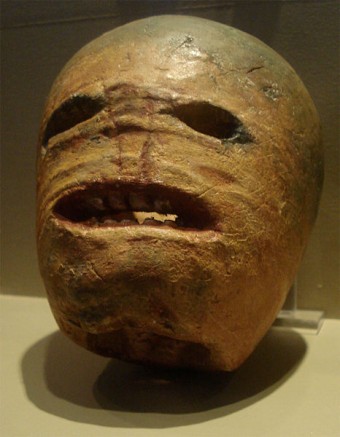Why are Carved Pumpkins Called “Jack O’ Lanterns”?
 The name “Jack O’ Lantern” was originally one of the numerous names given to ignis fatuus (Medieval Latin for “foolish fire”), another of which is “Will O’ the Wisps”, basically the odd light that can occasionally be seen over marshes, swamps, and the like. (See: What Causes Will O’ the Wisps?“) “Jack O’ Lantern” first popped up being used this way around the mid-17th century in East Anglia, UK and spread from there through parts of England, Ireland, and Scotland.
The name “Jack O’ Lantern” was originally one of the numerous names given to ignis fatuus (Medieval Latin for “foolish fire”), another of which is “Will O’ the Wisps”, basically the odd light that can occasionally be seen over marshes, swamps, and the like. (See: What Causes Will O’ the Wisps?“) “Jack O’ Lantern” first popped up being used this way around the mid-17th century in East Anglia, UK and spread from there through parts of England, Ireland, and Scotland.
This name likely originally derived from the practice of calling men generically “Dick, Jack, Tom, etc.” In particular, men who were lower class, were often called generically “Jack” beginning around the 14th century in England. (This practice popped up again in the late 19th century in the United States where “Jack” was used for the name for a man where his real name is unknown). Thus, when you see someone carrying a lantern in a distance at night that you see is a man, but you can’t make out who exactly it is, he is literally “man with a lantern”, a.k.a. “Jack of the Lantern” or “Jack O’ Lantern”. This was also commonly used for a nickname for night watchmen and the like around the same time “Jack O’ Lantern” first popped up, referring to ignis fatuus.
As to how this name made the jump to referring to carved pumpkins with lights inside, it has its origins in the Celtic practice of hollowing out and carving faces into turnips and other vegetables during Samuin (a festival where many of the traditions of Halloween come from). After carving the vegetables, they’d place candles inside and put them in windows or carry the make-shift lanterns with them as they walked to ward off evil spirits.
The tradition in various forms endured, including in Britain where pranksters would make these types of carved lanterns to scare people on the road or children would carry them around during Hallowmas while begging for soul cakes.
From here things get a little murkier in terms of tracing how exactly “Jack O’ Lantern” got applied to carved pumpkins. It is entirely possible that the above “man with a lantern” nickname of “Jack O’ Lantern” may have simply directly extended as a nickname for these carved turnip or vegetable lanterns without any intermediary. The first known instance of this application was in 1837 in Nathaniel Hawthorne’s The Great Carbuncle:
Hide it [the great carbuncle] under thy cloak, say’st thou? Why, it will gleam through the holes, and make thee look like a jack-o’-lantern!
On the other hand, given that it appears it was Irish immigrants to America who brought over the practice of carving and lighting vegetables and it appears it was they that adapted this practice to carving pumpkins for this purpose, it seems likely enough that the nickname did not make a direct jump from “man with a lantern” to “carved vegetable lantern”, but rather came via an Irish legend, Stingy Jack. (This legend sprung up around a century after the first known instance of “Jack O’ Lantern” referring to ignis fatuus.)
There are numerous versions of The Legend of Stingy Jack, but the general story is there was a sinful drunkard named Jack who encountered the Devil and convinced the Devil to come have a drink with him before the Devil would take him down to Hell. The Devil agreed and after Jack had drunk his fill, as he had no money, he asked the Devil to cover the bill. As the Devil had no use for money, he had none on him, so Jack suggested he transform himself into a silver coin so Jack could pay the bill. (Why Jack or the Devil would care about paying at this point in the story makes little sense, among other oddities, but shhhh! You’re interrupting the story.)
Once the Devil had transformed himself into the coin, rather than pay the bill, Jack quickly stuck the coin into a small money pouch which had a crucifix on it, trapping the Devil.
In order to get Jack to let him out, the Devil made a deal with Jack that he’d give him 10 more years of life. The bargain was struck and after 10 years, the Devil returned for Jack and Jack made the request that the Devil fetch him an apple from up a tree. The moronic Devil, who apparently lives to please, climbed the tree and fetched an apple for Jack. While he was up the tree, Jack carved a crucifix into the bark at the base of the tree, thereby trapping the Devil… who could apparently turn into a coin but couldn’t turn into a bird. Or, you know… couldn’t just hop down past the crucifix instead of climbing down when he reached that point…
A second deal was struck, this time with Jack demanding that the Devil never take his soul to Hell. The Devil agreed and, being known for honesty and integrity, kept his word once Jack let him go.
Of course, Jack eventually died (maybe he should have asked for immortality and eternal youth?) and upon arriving at Heaven’s gates, whoops! His sinful life made it so he couldn’t get in. He then went and visited the entrance to Hell to try to get in there (for some odd reason), but the Devil wouldn’t let him in owing to his previous promise. Being once again apparently kind and generous, the Devil did give Jack an ever burning coal from Hell to use to light his way / warn other people of Jack’s presence. Jack then placed it in a carved turnip (which apparently doomed souls have easy access to) and proceeded to wander the Earth for all eternity.
So whether it was a direct jump from the “man with a lantern” British slang to being associated with people holding vegetable lanterns and then the vegetable lantern itself or, probably more likely given how vegetable carving became popular in America, via the Irish Stingy Jack legend, the ultimate origin of why we call carved pumpkins “Jack O’ Lanterns” seems to be a melding of the ignis fatuus nickname, “Jack O’ Lantern”, with the Samuin practice of using hollowed out vegetables with candles inside to ward off evil spirits.
If you liked this article, and the Bonus Facts below, you might also like:
- Has Anyone Ever Actually Poisoned Or Put Razor Blades or Needles in Halloween Candy?
- Why are Witches Commonly Depicted Flying Around on Broomsticks?
- 15 Interesting Halloween Facts [Infographic]
- Where the Word “Witch” Came From
- Why Black Cats are Considered Unlucky
Bonus Facts:
- While there are a lot of myths surrounding Will O’ the Wisps, it is actually a real phenomenon, which perhaps shouldn’t be too surprising as just about every culture in the world has a legend surrounding mysterious dancing lights over marshes. Briefly, these lights are thought to be caused by oxidation of phosphine, methane, and diphosphane. These compounds are produced by organic decay, hence why the Will O’ the Wisps are often seen in marshes. (much more on this fascinating phenomenon in an upcoming article)
- The name “Will O’ the Wisps” has a similar meaning to “Jack O’ Lantern” (“man of the lantern”). In this case, coming from the definition for “wisp” (bundle of sticks or straw used for a torch), thus “Will of the Torch”. In this case, one of the principle legends behind the name concerns Will Smith… no, not that Will Smith, but rather a guy named Will who was a particularly evil blacksmith. There are a variety of versions of this legend, but the basic idea is that when he died and attempted to get into Heaven, Saint Peter gives him a second chance at life, but he blows it and ends up being doomed to walk the Earth forever, not unlike the Irish legend of Stingy Jack. Also like the Jack O’ Lantern legend, the Devil gives Smith an ever burning lump of coal to use as a light. But in this case, it is also to keep Smith warm in cold, damp places like marshes.
- The first known pumpkins were grown in Mexico around 6000-ish BC.
- The most Jack O’ Lanterns ever lit in one location was in Highwood, Illinois in 2011. The citizens of this town got together and carved and lit an astounding 30,919 pumpkins in close proximity to one another, beating the previous record by nearly 800 Jack O’ Lanterns.
- The world’s largest ever Jack O’ Lantern was carved in 2005 out of the then record largest pumpkin, which weighed 1,469 pounds and was grown by Scot Cully in Pennsylvania.
- The record for the largest pumpkin ever grown has been broken numerous times in the last few decades, but at present, the record holder is Ron Wallace, who grew a pumpkin that weighed 2,009 pounds (weighed in on September 30, 2012). The previous world record holder held that title for just five days, Steve Geddes, who grew a pumpkin that weighed 1843.5 pounds. For reference, just 31 years ago the largest recorded pumpkin ever grown was just 460 pounds.
- The pumpkin size explosion was thanks partially to a Nova Scotian man, Howard Dill, who broke the previously mentioned 460 pound record with a 493.5 pound pumpkin. He then patented and started selling “Dill’s Atlantic Giant seeds”, which various growers have used and crossed with other variety’s to create even bigger pumpkins, with nearly all the record holders since Dill using some variety of seed that stemmed from Dill’s Atlantic Giant seeds.
- The word “pumpkin” ultimately came from the Greek “peptein” meaning “to cook”. This gave rise to the Greek “pepon” and the Latin “peponem”, both meaning “melon”. The Latin “peponem” is where the Middle French “pompon” came from, also meaning “melon”. Finally, in the mid-17th century we have the word “pumpion” in English meaning melon, which “pumpkin” derived from, the latter of which was coined by early English speaking colonists to the Americas.
- Approximately one and a half billion pounds of pumpkin are grown in the United States alone every year, with about 85% of pumpkins that are further processed for food-type items grown by Nestlé. Further, about 95% of all pumpkins in the U.S. which will be further processed before sale, rather than just sold as picked, are grown in Illinois.
- If your dog or cat is showing signs of constipation or diarrhea (or hairballs for cats), a nice home remedy often recommended by vets for helping “cure” these problems is to feed them canned pumpkin; presumably the same would be true for humans.
| Share the Knowledge! |
|






The World Record pumpkin is now set a 2323.7 pound grown in 2014 by Beni Meier from Switzerland .
http://www.bigpumpkins.com/ViewArticle.asp?id=186&gid=62
A new world record is grown almost ever year.
I am know the largest Jack-O-Lantern ever is more than Scot Cully’s 1469 pumpkin – but I don’t know what the record is.